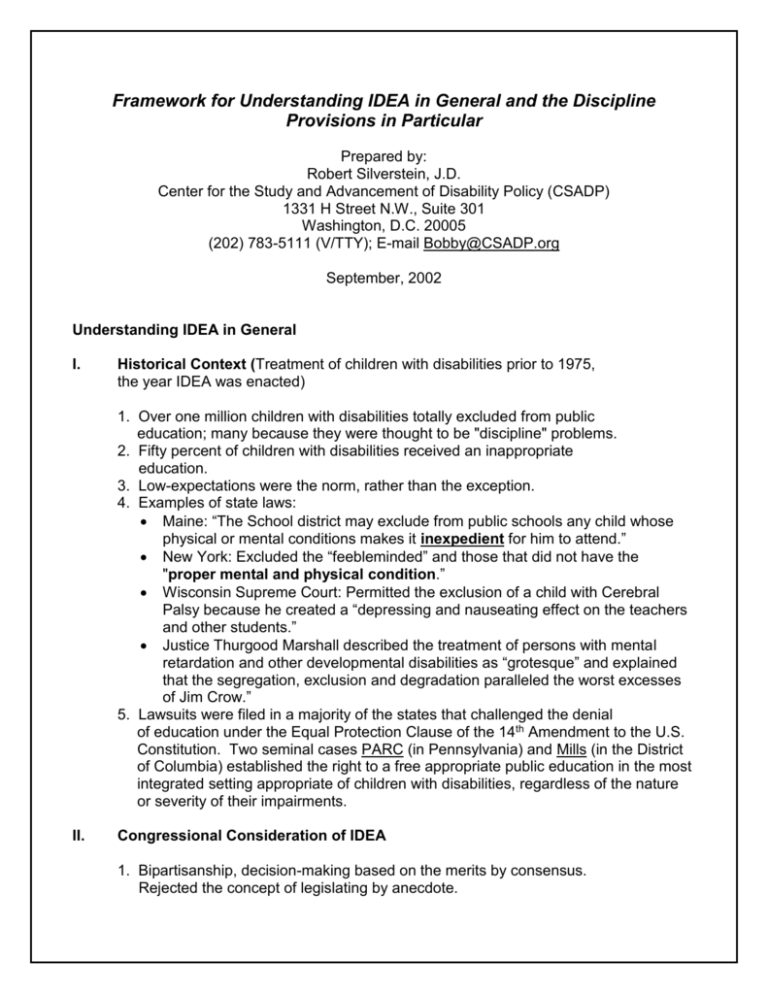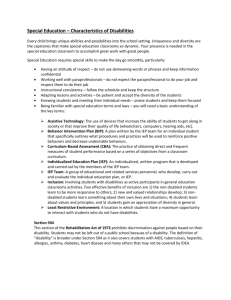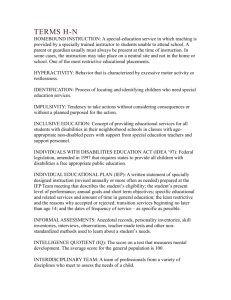Framework for Understanding IDEA in General and the Discipline
advertisement

Framework for Understanding IDEA in General and the Discipline Provisions in Particular Prepared by: Robert Silverstein, J.D. Center for the Study and Advancement of Disability Policy (CSADP) 1331 H Street N.W., Suite 301 Washington, D.C. 20005 (202) 783-5111 (V/TTY); E-mail Bobby@CSADP.org September, 2002 Understanding IDEA in General I. Historical Context (Treatment of children with disabilities prior to 1975, the year IDEA was enacted) 1. Over one million children with disabilities totally excluded from public education; many because they were thought to be "discipline" problems. 2. Fifty percent of children with disabilities received an inappropriate education. 3. Low-expectations were the norm, rather than the exception. 4. Examples of state laws: Maine: “The School district may exclude from public schools any child whose physical or mental conditions makes it inexpedient for him to attend.” New York: Excluded the “feebleminded” and those that did not have the "proper mental and physical condition.” Wisconsin Supreme Court: Permitted the exclusion of a child with Cerebral Palsy because he created a “depressing and nauseating effect on the teachers and other students.” Justice Thurgood Marshall described the treatment of persons with mental retardation and other developmental disabilities as “grotesque” and explained that the segregation, exclusion and degradation paralleled the worst excesses of Jim Crow.” 5. Lawsuits were filed in a majority of the states that challenged the denial of education under the Equal Protection Clause of the 14th Amendment to the U.S. Constitution. Two seminal cases PARC (in Pennsylvania) and Mills (in the District of Columbia) established the right to a free appropriate public education in the most integrated setting appropriate of children with disabilities, regardless of the nature or severity of their impairments. II. Congressional Consideration of IDEA 1. Bipartisanship, decision-making based on the merits by consensus. Rejected the concept of legislating by anecdote. 2. IDEA is a civil rights law. IDEA includes procedural and substantive responsibilities that guarantee a "basic floor of opportunity" for a child with a disability. If IDEA were repealed, responsibilities to provide a free appropriate public education would still exist under Section 504 of the Rehabilitation Act, the ADA and the 14th Amendment. 3. IDEA is also a formula grant program providing assistance to help school districts meet their constitutional responsibilities to children with disabilities. Congress established a ceiling or goal of assistance at 40% of the average per pupil expenditure in public elementary and secondary schools in the U.S. III. Core Policies Included in IDEA 1. Precept: Disability, like race and gender, is a natural part of the human experience that in no way diminishes a person’s right to fully participate in all aspects of society, including the receipt of a free appropriate public education. 2. Goals: Ensure that every child with a disability receives an effective and meaningful educational opportunity that prepares him/her to lead an independent life and enjoy economic self-sufficiency. 3. Parent/Educator Partnership: Empower parents to participate in decisions affecting their children's education as meaningful partners with educators. 4. Zero Reject: Provide services to all children with disabilities, regardless of the nature or severity of their disability. Leave no child behind. 5. Individualization: Make decisions based on facts and objective evidence provided by interdisciplinary teams and parents. Determine appropriate interventions and services through an IEP to address the unique needs of each child based on promising practices derived from research. 6. Genuine, Effective and Meaningful: Based on data and research, provide appropriate special education and related services that will provide a genuine, meaningful and effective educational opportunity, including access to the general curriculum. 7. Most Integrated Setting Appropriate: Presumption is that a child with a disability can benefit from instruction in regular class with supplementary aids and services. Presumption is rebuttable based on what is appropriate for the child. 8. IEP Partnership (joint problem-solving) Hand shake agreement between the parents and the school district Like a contract--both parties bound 9. Procedural Safeguards Stay Put (parents cannot unilaterally decided to change placement if school district disagrees; similarly school district cannot unilaterally change placement unless parents agree) Due process--provides a formal mechanism for resolving disagreements Private right of action, including attorneys fees for prevailing parents 10. Monitoring and Enforcement By Feds 2 By states NCD report, President's Commission Report, U.S. Department of Education's Annual Report to Congress 11. Methods of Administration Accountability for results (high expectations) e.g., district and statewide assessments Comprehensive System of Personnel Development Parent training and information Research, demonstrations, technical assistance IV. Context (Numbers of due process hearings held per year) 1. Number of due process hearings per year. Over 6 million children with disabilities served Approximately 3000 due process hearings per year and the number of hearings held are declining. This means that there is no need for a hearing for 99.95% of the children with disabilities. 2. Point of view. School Officials assert that the numbers of hearings held are deflated because they give in just to avoid hassles. Representatives of middle class parents assert that the numbers of due process hearings are deflated because they give in to avoid a hassle. Representatives of poor parents assert that significant numbers of parents have no idea whatsoever of their rights (ignorant of rights). Thus, they never initiate due process. V. Summary of Themes 1. Most of the time parents and educators agree. 2. Zero reject--no child with a disability can be excluded. 3. Make decisions based on facts, objective evidence, research, and promising practices agreed to by a group of persons, including parents. 4. Partnerships between parents and educators. Hand shakes between parties with expectation that each side will abide by terms of the agreement. 5. Message: Focus on the child. Don't blame the child. Try hard, then try harder, then try even harder rather than exclude or segregate when child deemed hard to serve. 6. Accountability. Parents may challenge decisions made by professionals, including mechanisms for making school personnel properly implement the law. 3 Understanding the Discipline Provisions in IDEA I. Background A. Development of 1997 Discipline Provisions 1. Bipartisan, bicameral working group led by the Senate Majority Leader Trent Lott's Chief of Staff. 2. Focused on the merits of the issue, consistent with agreed-upon themes. Rejected legislating by anecdote. B. Themes 1. Provide flexibility to school officials to ensure that schools are safe and conducive to learning for all children, including children with disabilities. 2. Take into consideration the consequences of actions within schools on the safety of the community. 3. Ensure that all students are taught personal responsibility and held to standards of personal responsibility for their actions, consistent with their ability to understand. 4. Base decisions concerning discipline on facts and objective evidence, promising practices (research), not fear or anecdote. 5. Individualize interventions to maximize the likelihood that inappropriate behavior does not re-occur. 6. Do not blame or punish students with disabilities for the failure of the school system to develop appropriate interventions, the failure to implement the IEP by providing appropriate services by trained and qualified staff or when their disability prevents them from understanding the consequences of their behavior. 7. Don't blame or punish students with disabilities because of their disability. 8. Take into consideration the history of exclusion, segregation, and denial of appropriate services based on assertions related to discipline. 9. Recognize the significance of the message that is communicated by the policy (understand the unintended consequences of a change in policy). 10. Do not interfere with the legitimate functioning of the juvenile justice system. 11. Do not allow gaming the system by nondisabled children. II. Overview of the Discipline Provisions 1. Context. Remember 99.95% of the times parents and school officials agree on what is appropriate action for disciplining children with disabilities. 2. Message: Try hard and then try harder before you exclude or 4 3. 4. 5. 6. 7. 8. III. segregate a disabled child unless the child poses a danger to self or others. Approach. Make decisions based on facts, objective evidence, research and promising practices. Functional assessments and behavioral intervention plans. IEP mutual agreement. Handshake. Discipline provision revolves around the issue when should a school official be able to unilaterally breach the agreement with parents and unilaterally change a disabled child’s placement. Called the stay put provision. Circumstances when school officials can unilaterally renege on the agreement with parents: Short term (10 day) suspensions that do not constitute a pattern Weapons and drugs (unilateral) Substantial likelihood of injury to self or others (hearing officer or court) Placement in alternative settings Committed a crime ok to report and refer to police and juvenile and criminal justice authorities to the same extent as report and refer nondisabled students. Circumstances when ok to use same disciplinary sanctions used with nondisabled students (not a manifestation). Subject to stay put. No cessation of services. Zero reject. Reagan, Carter, Bush, Clinton, Bush Administrations all endorsed no cessation. Safe communities (Police rejection of cessation) the likely result of putting children with special needs on the street without professional supervision is jail or more violence. Virtually all school groups reject cessation. Services to the extent necessary to enable a child to progress in the general curriculum and achieve the goals set out in the IEP and to prevent the behavior from recurring. Double Standard 1. IDEA requires individualization and decisions based on facts and objective evidence and interventions based on research and promising practices designed to maximize the likelihood that inappropriate behavior does not recur. No cessation of services--concern for long-term impact of child in the school (inappropriate behavior does not reoccur) and safety of community. 2. To the extent that school officials treat nondisabled children differently the question is whether all children should be held to IDEA standards (which are based on research and promising practices) not whether disabled children should be subjected to policy based on fear and anecdote. 5 IV. What Are the Real Issues? 1. Accountability. Should teachers and school officials be permitted to act unilaterally and with unfettered discretion when it comes to the treatment of children with disabilities. If so, under what circumstances? Should parents be empowered to challenge the appropriateness of their actions (level the playing field)? If so, under what circumstances? 2. Implementation of IDEA. Why is it that IDEA implementation is not a problem is some schools or school districts and such a major problem in other districts? Why is it that some teachers and some principals and some administrators are able to maintain safe schools without wholesale suspensions and expulsions and understand and appreciate the message of IDEA and others pursue wholesale suspensions and want children disabled out of their schools? 3. Legislate on the Merits Not by Anecdote. Given that 99.95% of the time there is no disagreement between educators and parents, how does one devise a public policy that does not have the unintended consequence of reaching significant numbers of additional situations. 4. Message. What is the message to gets to local school personnel? Is it: Problem-solve based on promising practices and research in partnership with parents by focusing on the unique needs of each disabled child and try hard to maximize the likelihood that the child learns personal responsibility and that inappropriate behavior does not recur. Or It is ok to kick out children with disabilities when it is deemed inexpedient to serve them because they take up too much time and resources. In other words, it is ok to leave certain children behind? 5. Focus. Should the focus of the public policy be limited to short, midterm, and/or long term consequences of school official’s actions? Should the focus include the consequences of actions by school officials for the child, family and the community as well as in the schools? 6. Monitoring and enforcement. Why should so much of the monitoring and enforcement responsibility be placed on parents? 6







